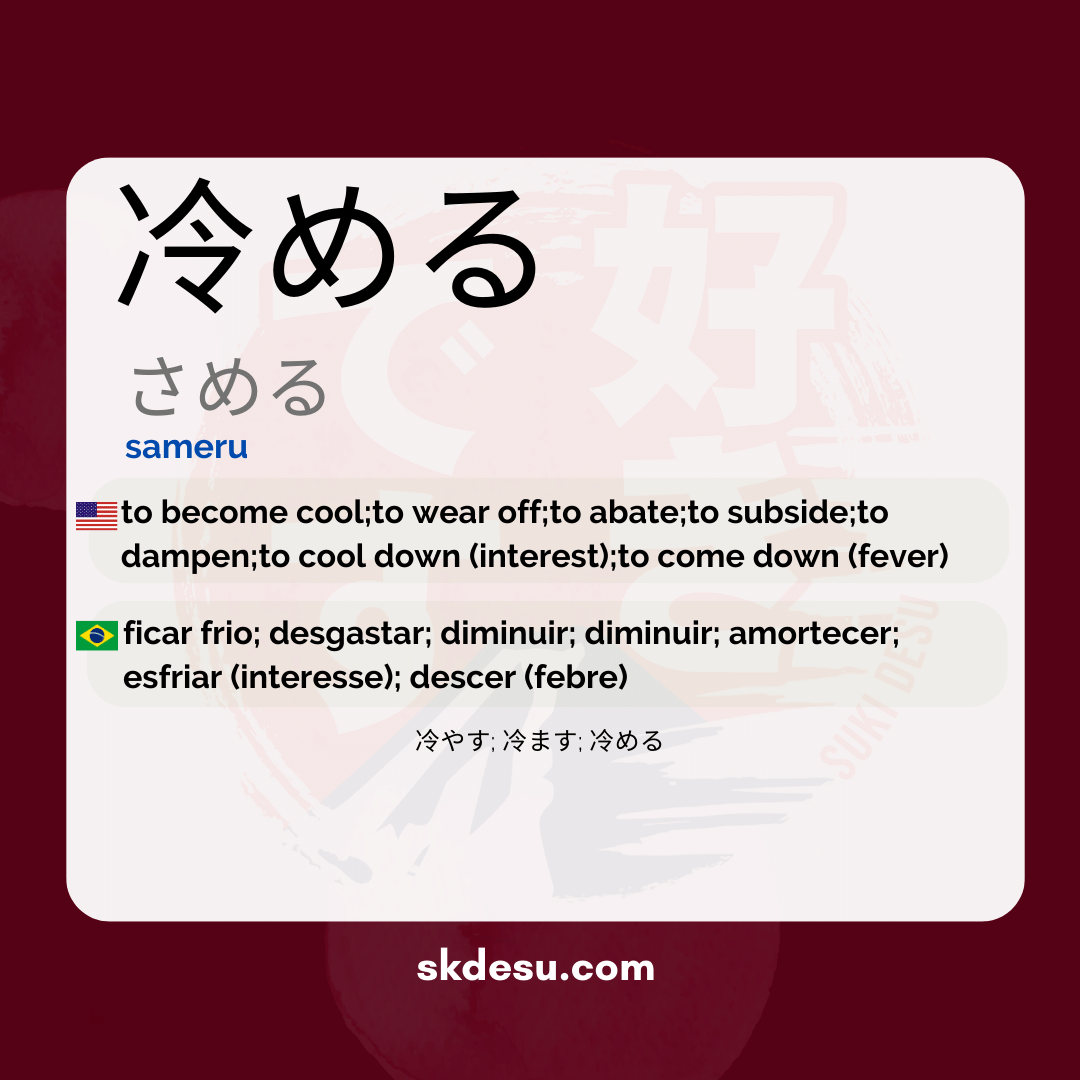Translation and Meaning of: 冷める - sameru
The Japanese word 冷める (さめる, sameru) may seem simple at first glance, but carries interesting nuances worth exploring. If you are learning Japanese or simply curious about the language, understanding its meaning, everyday use, and cultural context can enrich your knowledge. In this article, we will unravel everything from the basic translation to how this word is perceived in Japan, including tips for memorization and practical examples.
冷める is a verb that describes something that "cools down" or "loses heat," whether literally, like a cup of tea, or metaphorically, like a feeling that dissipates. In the Suki Nihongo dictionary, you will find not only its definition but also example sentences that show its real-life application. Let's dive into the details that make this word a useful piece of the Japanese vocabulary.
Meaning and usage of 冷める
冷める is often used to describe physical objects that have lost heat, such as food or drink. For example, when coffee cools, you can say "コーヒーが冷めた" (kōhī ga sameta). However, its use goes beyond the literal meaning. In everyday language, Japanese people also use 冷める to express the cooling of emotions or relationships, as in "彼の熱意が冷めた" (kare no netsui ga sameta – "his enthusiasm has cooled down").
This duality between the physical and the emotional is what makes 冷める a versatile word. Unlike 冷える (hieru), which tends to describe something already cold or in the process of cooling, 冷める implies a change of state – from hot to cold. This subtlety is important for those who want to sound natural when speaking Japanese.
Origin and components of kanji
The kanji 冷 is composed of the radical 冫 (which represents ice) and the component 令 (which originally conveyed the idea of "to order" or "to decree"). Together, they create the meaning of "cold" or "to cool." Interestingly, this same kanji appears in other words such as 冷たい (tsumetai – "cold to the touch") and 冷凍 (reitou – "freezing"), showing its constant connection with the idea of low temperature.
The reading さめる (sameru) is classified as kun'yomi, meaning the native Japanese pronunciation associated with the meaning of the kanji. When 冷 appears in compounds with other kanjis, it typically uses the on'yomi reading れい (rei), as in 冷静 (reisei – "calm, serene"). Understanding this difference helps predict how the kanji will be pronounced in various words.
Sameru in Japanese culture
In Japan, where the presentation and temperature of food hold significant cultural importance, 冷める frequently appears in culinary contexts. Dishes like rice are especially appreciated when served at the ideal temperature, and saying that "ご飯が冷めた" (gohan ga sameta) carries a negative connotation, suggesting that the food has lost its best moment for consumption.
Metaphorically, the use of 冷める to describe relationships or passions that have cooled reflects an interesting aspect of Japanese communication. Instead of more direct expressions, this more subtle language is often chosen. A classic example is the phrase "恋が冷めた" (koi ga sameta), which describes when romantic love dissipates, showing how Japanese often uses natural metaphors for emotional states.
Tips for memorizing and using 冷める
An effective way to memorize 冷める is to associate it with concrete situations. Think of moments when something literally cooled down – like soup or a bath – and create simple sentences. Another strategy is to contrast it with antonyms like 温める (atatameru – "heat up") to create vocabulary pairs. This method of learning by opposition is proven to be effective for memorizing foreign languages.
For those who use apps like Anki, creating cards with images of things cooling down (like steam rising from a cup that gradually disappears) can help consolidate meaning. The key is to connect the word to sensory experiences, as 冷める precisely describes a noticeable change in temperature or feeling.
Vocabulary
Expand your vocabulary with related words:
Verb conjugation of 冷める
- 冷まし - て form imperative
- 冷めた - past form
- 冷める - basic form
- 冷めろ - imperative form
- 冷めない - negative form
- 冷めそう - potential form
Synonyms and similar words
- 冷やす (Hiyasu) - Chill something, usually a drink or food, intentionally.
- 冷ます (Samasu) - Let something cool down, typically a liquid or food, after heating it.
- 冷める (Sameru) - Cool down, referring to the state of something that has become cold, usually without direct intervention.
Related words
Romaji: sameru
Kana: さめる
Type: verb
L: jlpt-n2
Translation / Meaning: to cool down; to wear out; to decrease; to diminish; to cushion; to lose interest; to reduce (fever)
Meaning in English: to become cool;to wear off;to abate;to subside;to dampen;to cool down (interest);to come down (fever)
Definition: Allow food or drinks to become familiar while still hot.
Quick Access
- Vocabulary
- Writing
- Sentences
How to Write in Japanese - (冷める) sameru
See below a step-by-step guide on how to write the word by hand in Japanese. (冷める) sameru:
Example Sentences - (冷める) sameru
See below some example sentences:
Kono kōhī wa samete shimatta
This coffee has cooled down.
This coffee has cooled down.
- この - demonstrative pronoun that means "this" or "this here"
- コーヒー - noun meaning "coffee"
- は - topic particle that indicates the subject of the sentence, in this case "this coffee"
- 冷めてしまった - verb that means "completely cooled down" or "became too cold"
Other Words of this Type: verb
See other words from our dictionary that are also: verb

